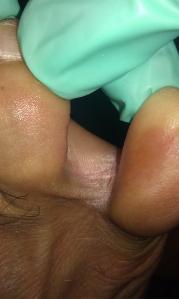Athlete’s Foot (tinea pedis) commonly occurs in diabetics. Since the flaking and peeling skin symptomatic of this fungal infection can resemble large areas of dry skin, affected clients often mistake it for very dry skin. At McDermott Footcare, monitoring the presence of Athlete’s Foot in diabetic clients is part of the routine, on-going assessment.
What does Athlete’s Foot look like?
The appearance of Athlete’s Foot was described in this earlier blog post (read here), but it bears repeating.
In its beginning stage, Athlete’s Foot shows up as flaky, scaly, peeling skin between the toes, most likely between the fourth and fifth toes. There may also be superficial cracking or fissures of the skin between the toes.

The flaky, scaly area may spread down the soles of the foot. As it spreads, the affected area often becomes reddened and may feel itchy or burning. It may develop into moccasin-type Athlete’s Foot, covering an area that would typically be covered by a moccasin-type shoe.
Athlete’s Foot concerns for diabetics
Athlete’s Foot that remains untreated may cause abrasions, small cuts and bleeding in the skin. This provides an opportunity to develop a bacterial infection known as cellulitis.
Cellulitis is a non-contagious bacterial infection that may occur secondary to Athlete’s Foot. Diabetics are more prone to developing cellulitis because of a weakened immune system. It is characterized by redness, swelling, warmth, tenderness and tightness of the skin in the affected area. Oral antibiotics are prescribed as treatment. If cellulitis does not respond well to antibiotic therapy, areas of blackened, necrotized or dead tissue may develop, which may result in amputation.
The circulatory system is weaker in people with diabetes. Poor circulation causes weakening of the immune system, which causes increased risk of infection. Any infection left untreated can be dangerous. For a diabetic, the danger increases since unresolved infections in the feet and lower limbs are a leading cause of amputations. That’s why even mild Athlete’s Foot becomes a concern.
Steps to prevent and treat Athlete’s Foot at home were addressed in a previous McDermott Footcare blog (read here). It is important for everyone, but especially diabetics, to understand these steps for preventing the fungal infection. For diabetics, the home remedies should be used as part of a comprehensive treatment plan which includes prescribed anti-fungal creams or ointment from your doctor.
